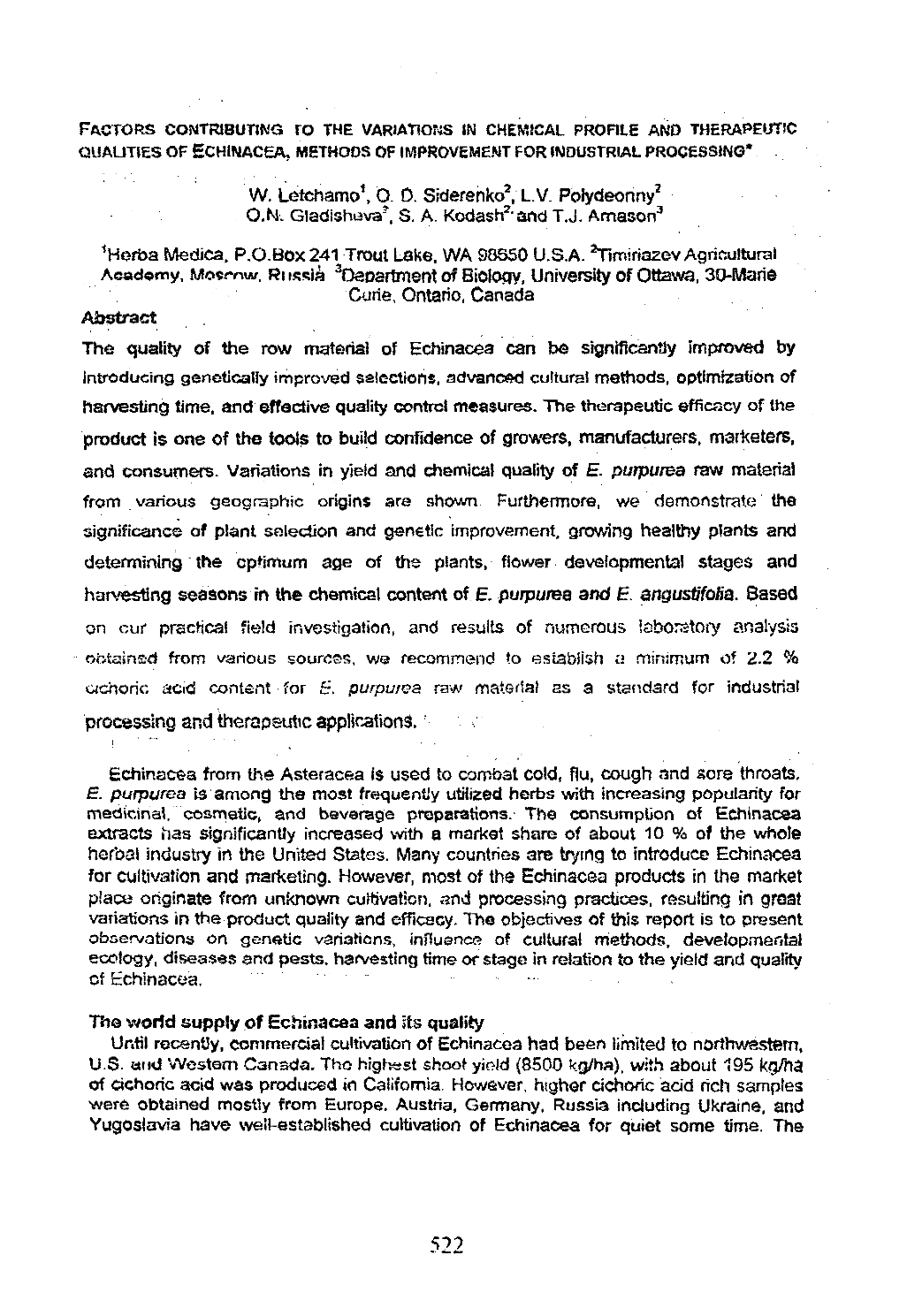

F
a c to r s
c o n tr ib u tin g
го
the
variatio ns
in
chem ical
pro file
a n d
thera peutic
QUALITIES OF ECHINACEA, METHODS OF IMPROVEMENT FOR INDUSTRIAL PROCESSING*
W. Letchamo1, O. D. Siderenko2, L.V. Pofydeonny2
O.FLGladisheva*. S. A. Kodash2 and T.J. Arnason3
1Horba Medica, P.O.Box 241 Trout Lake, WA S8S50 U.S.A. ^Timiriazev Agricultural
Academy, Mo«mw, Ri issia 3Dadariment of Biology, University of Ottawa, 30-Mane
Curie, Ontario, Canada
A bstract
The quality of the row material of Echinacea can be significantly Improved by
introducing
genetically
improved selections, advanced
cultural
methods, optimization of
harvesting time, and effective quality control measures. The therapeutic efficacy of the
product is one of the tools to build confidence of growers, manufacturers, marketers,
and consumers. Variations in yield and chemical quality of
E. purpurea
raw material
from various geographic origins are shown Furthermore, we demonstrate the
significance of plant selection and genetic improvement, growing healthy plants and
determining the optimum age of the plants, flower developmental stages and
harvesting seasons in the chemical content of
E. purpurea
and
E ongustifoiia.
Based
on cur practical field investigation, and results of numerous laboratory analysis
obtained from various sources, we recommend to establish a minimum of 2.2 %
achoric acid content for
E, p u rp u rea
raw material as a standard for industrial
processing and
therapeutic
applications.
Echinacea from the Asteracea is used to combat cold, flu, cough and sore throats,
E. purpurea
is among the most frequently utilized herbs with increasing popularity for
medicinal, cosmetic, and beverage preparations. The consumption of Echinacea
extracts has significantly increased with a market share of about 10 % of the whole
herbal industry in the United States. Many countries are trying to introduce Echinacea
for cultivation and marketing. However, most of the Echinacea products in the market
place originate from unknown cultivation, end processing practices, resulting in great
variations in the product quality and efficacy. The objectives of this report is to present
observations on genetic variations,
influence
of cultural methods, developmental
ecology, diseases end pests, harvesting time or stage in relation to the yield and quality
of Echinacea,
The w orld supply o f Echinacea and its quality
Until recently, commercial cultivation of Echinacea had been limited to northwestern,
U S . and Western Canada. Tho highest shoot yield (8500 kg/ha), with about 195 kg/ha
of cichoric acid was produced in California. However, higher cichoric add rich samples
were obtained mostly from Europe. Austria, Germany, Russia including Ukraine, and
Yugoslavia have well-established cultivation of Echinacea for quiet some time. The
Научная электронная библиотека ЦНСХБ









